Comparative Analysis of Competitive Strategies for PayPal and Subway
VerifiedAdded on 2020/03/04
|8
|1683
|59
Report
AI Summary
This report provides a comprehensive analysis of the competitive strategies and business model innovations employed by PayPal and Subway. It begins with an overview of PayPal, detailing its evolution from a money-transfer company to a global online-payment platform, and examines its strategic decisions, including its acquisition by eBay and partnerships. The report then shifts to Subway, exploring its strategic focus on fresh, nutritious food and its innovative approach to franchise ownership and market positioning within the fast-food industry. The analysis highlights key aspects of their business models, market trends, and competitive advantages, providing insights into how these companies have achieved success in their respective fields. The report uses references to support the analysis of both companies' strategies.
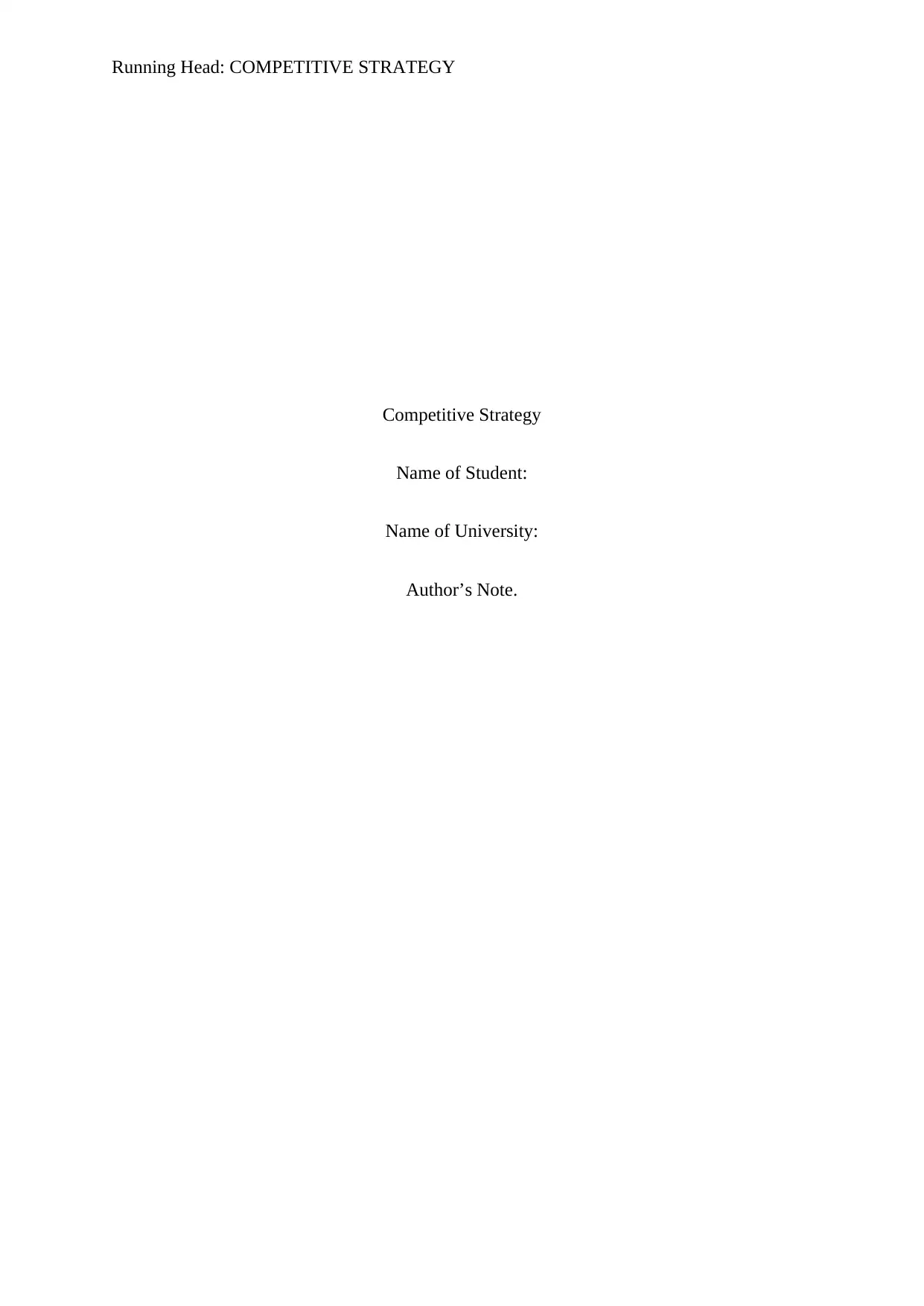
Running Head: COMPETITIVE STRATEGY
Competitive Strategy
Name of Student:
Name of University:
Author’s Note.
Competitive Strategy
Name of Student:
Name of University:
Author’s Note.
Paraphrase This Document
Need a fresh take? Get an instant paraphrase of this document with our AI Paraphraser
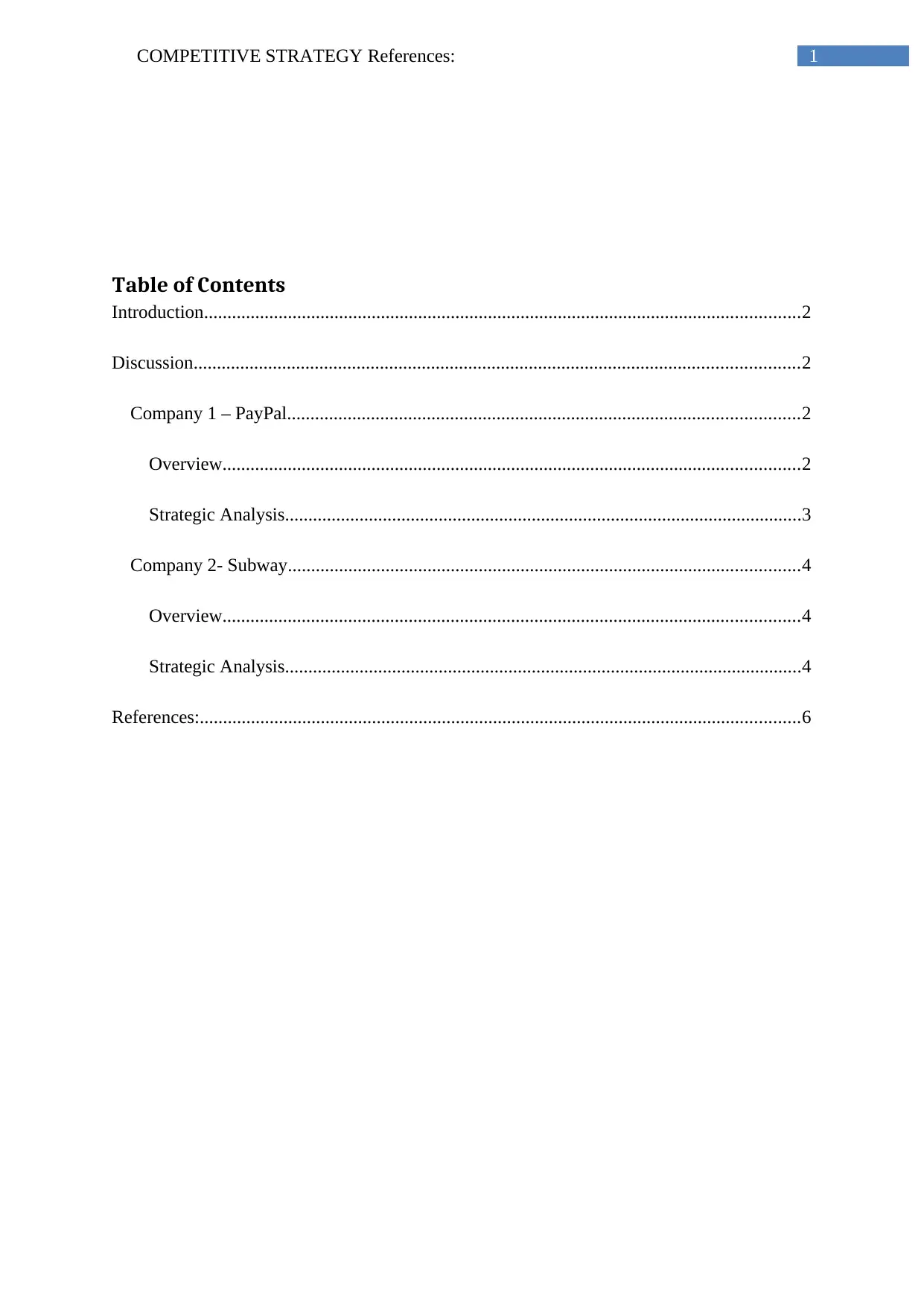
1COMPETITIVE STRATEGY References:
Table of Contents
Introduction................................................................................................................................2
Discussion..................................................................................................................................2
Company 1 – PayPal..............................................................................................................2
Overview............................................................................................................................2
Strategic Analysis...............................................................................................................3
Company 2- Subway..............................................................................................................4
Overview............................................................................................................................4
Strategic Analysis...............................................................................................................4
References:.................................................................................................................................6
Table of Contents
Introduction................................................................................................................................2
Discussion..................................................................................................................................2
Company 1 – PayPal..............................................................................................................2
Overview............................................................................................................................2
Strategic Analysis...............................................................................................................3
Company 2- Subway..............................................................................................................4
Overview............................................................................................................................4
Strategic Analysis...............................................................................................................4
References:.................................................................................................................................6
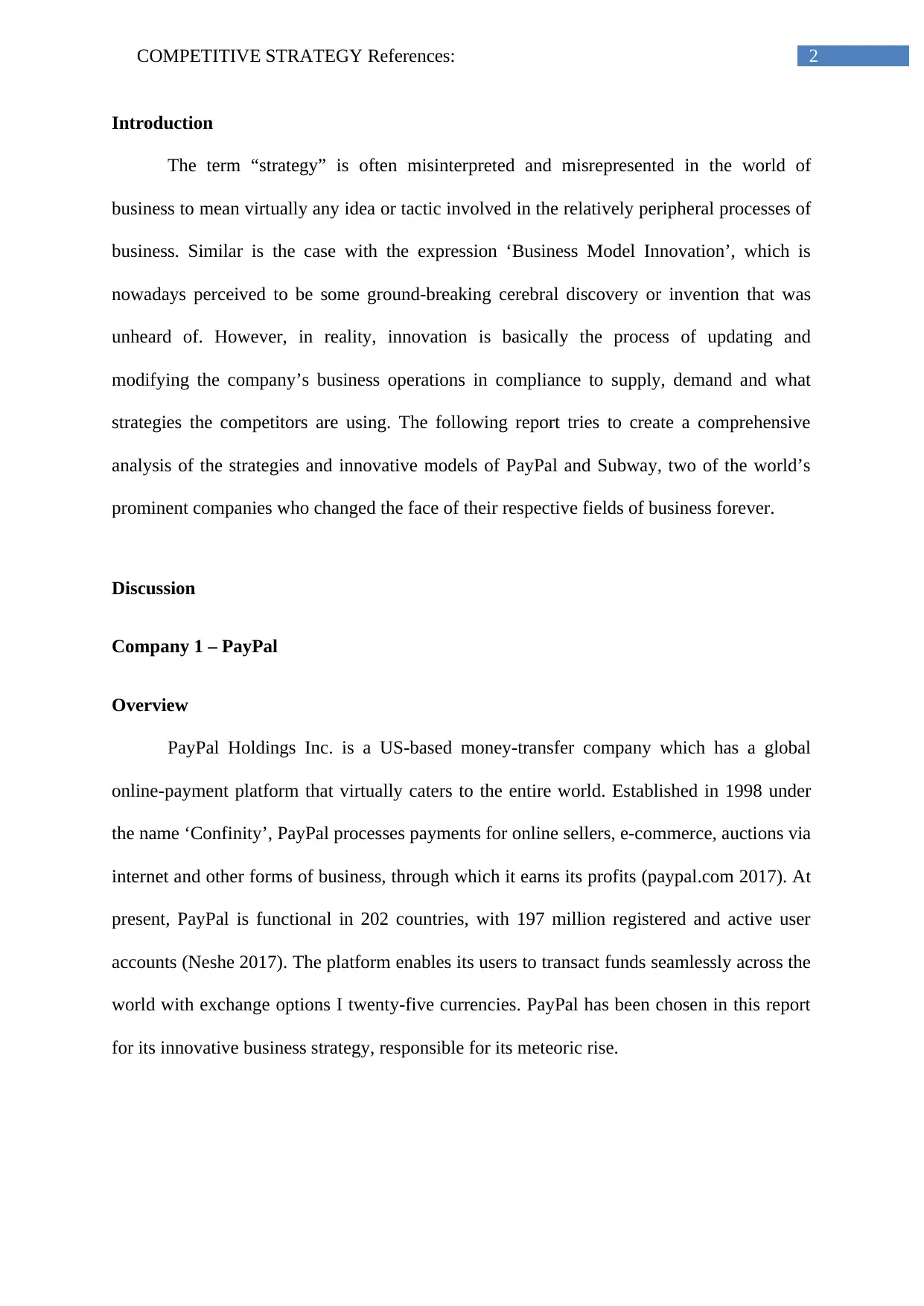
2COMPETITIVE STRATEGY References:
Introduction
The term “strategy” is often misinterpreted and misrepresented in the world of
business to mean virtually any idea or tactic involved in the relatively peripheral processes of
business. Similar is the case with the expression ‘Business Model Innovation’, which is
nowadays perceived to be some ground-breaking cerebral discovery or invention that was
unheard of. However, in reality, innovation is basically the process of updating and
modifying the company’s business operations in compliance to supply, demand and what
strategies the competitors are using. The following report tries to create a comprehensive
analysis of the strategies and innovative models of PayPal and Subway, two of the world’s
prominent companies who changed the face of their respective fields of business forever.
Discussion
Company 1 – PayPal
Overview
PayPal Holdings Inc. is a US-based money-transfer company which has a global
online-payment platform that virtually caters to the entire world. Established in 1998 under
the name ‘Confinity’, PayPal processes payments for online sellers, e-commerce, auctions via
internet and other forms of business, through which it earns its profits (paypal.com 2017). At
present, PayPal is functional in 202 countries, with 197 million registered and active user
accounts (Neshe 2017). The platform enables its users to transact funds seamlessly across the
world with exchange options I twenty-five currencies. PayPal has been chosen in this report
for its innovative business strategy, responsible for its meteoric rise.
Introduction
The term “strategy” is often misinterpreted and misrepresented in the world of
business to mean virtually any idea or tactic involved in the relatively peripheral processes of
business. Similar is the case with the expression ‘Business Model Innovation’, which is
nowadays perceived to be some ground-breaking cerebral discovery or invention that was
unheard of. However, in reality, innovation is basically the process of updating and
modifying the company’s business operations in compliance to supply, demand and what
strategies the competitors are using. The following report tries to create a comprehensive
analysis of the strategies and innovative models of PayPal and Subway, two of the world’s
prominent companies who changed the face of their respective fields of business forever.
Discussion
Company 1 – PayPal
Overview
PayPal Holdings Inc. is a US-based money-transfer company which has a global
online-payment platform that virtually caters to the entire world. Established in 1998 under
the name ‘Confinity’, PayPal processes payments for online sellers, e-commerce, auctions via
internet and other forms of business, through which it earns its profits (paypal.com 2017). At
present, PayPal is functional in 202 countries, with 197 million registered and active user
accounts (Neshe 2017). The platform enables its users to transact funds seamlessly across the
world with exchange options I twenty-five currencies. PayPal has been chosen in this report
for its innovative business strategy, responsible for its meteoric rise.
⊘ This is a preview!⊘
Do you want full access?
Subscribe today to unlock all pages.

Trusted by 1+ million students worldwide
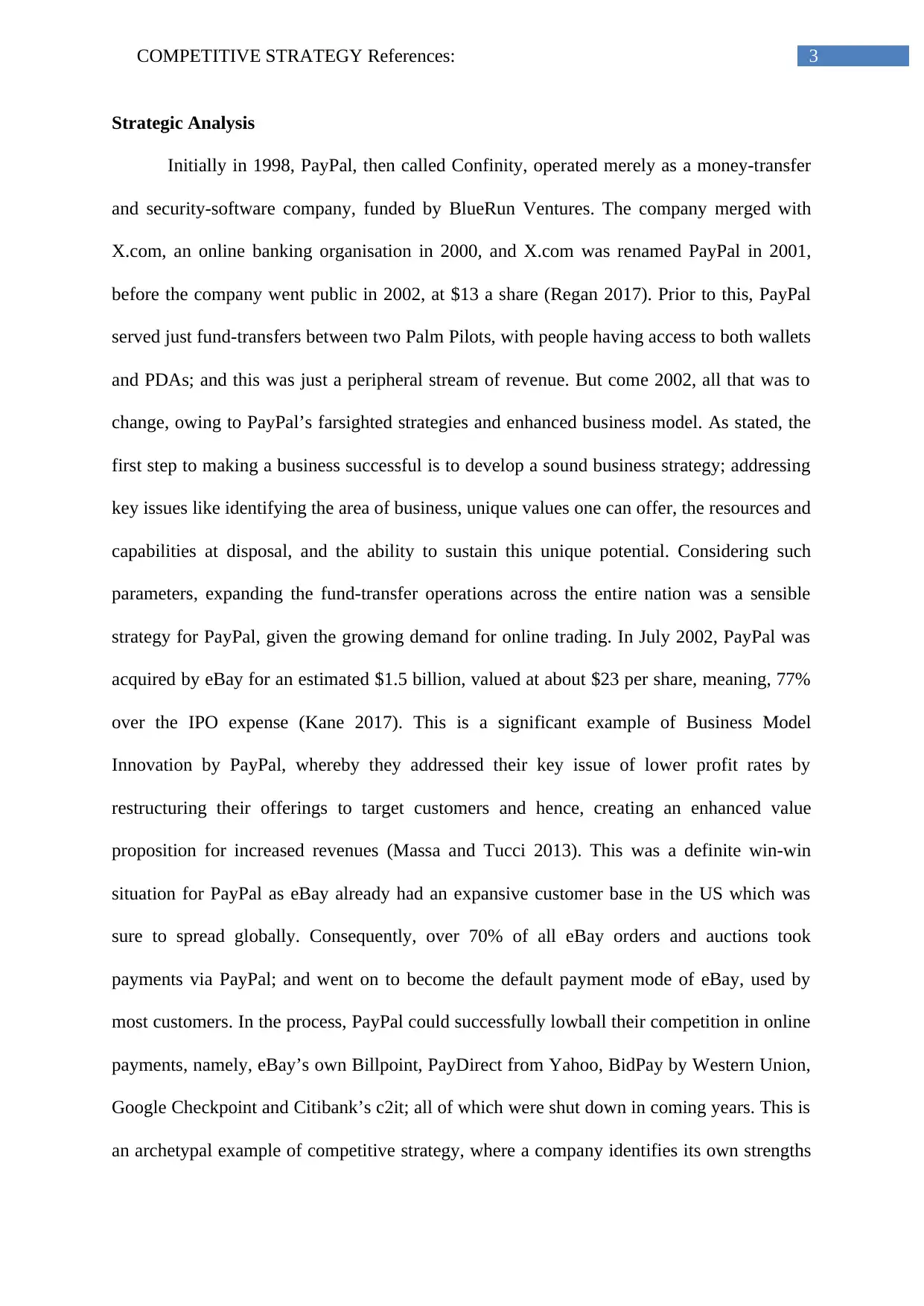
3COMPETITIVE STRATEGY References:
Strategic Analysis
Initially in 1998, PayPal, then called Confinity, operated merely as a money-transfer
and security-software company, funded by BlueRun Ventures. The company merged with
X.com, an online banking organisation in 2000, and X.com was renamed PayPal in 2001,
before the company went public in 2002, at $13 a share (Regan 2017). Prior to this, PayPal
served just fund-transfers between two Palm Pilots, with people having access to both wallets
and PDAs; and this was just a peripheral stream of revenue. But come 2002, all that was to
change, owing to PayPal’s farsighted strategies and enhanced business model. As stated, the
first step to making a business successful is to develop a sound business strategy; addressing
key issues like identifying the area of business, unique values one can offer, the resources and
capabilities at disposal, and the ability to sustain this unique potential. Considering such
parameters, expanding the fund-transfer operations across the entire nation was a sensible
strategy for PayPal, given the growing demand for online trading. In July 2002, PayPal was
acquired by eBay for an estimated $1.5 billion, valued at about $23 per share, meaning, 77%
over the IPO expense (Kane 2017). This is a significant example of Business Model
Innovation by PayPal, whereby they addressed their key issue of lower profit rates by
restructuring their offerings to target customers and hence, creating an enhanced value
proposition for increased revenues (Massa and Tucci 2013). This was a definite win-win
situation for PayPal as eBay already had an expansive customer base in the US which was
sure to spread globally. Consequently, over 70% of all eBay orders and auctions took
payments via PayPal; and went on to become the default payment mode of eBay, used by
most customers. In the process, PayPal could successfully lowball their competition in online
payments, namely, eBay’s own Billpoint, PayDirect from Yahoo, BidPay by Western Union,
Google Checkpoint and Citibank’s c2it; all of which were shut down in coming years. This is
an archetypal example of competitive strategy, where a company identifies its own strengths
Strategic Analysis
Initially in 1998, PayPal, then called Confinity, operated merely as a money-transfer
and security-software company, funded by BlueRun Ventures. The company merged with
X.com, an online banking organisation in 2000, and X.com was renamed PayPal in 2001,
before the company went public in 2002, at $13 a share (Regan 2017). Prior to this, PayPal
served just fund-transfers between two Palm Pilots, with people having access to both wallets
and PDAs; and this was just a peripheral stream of revenue. But come 2002, all that was to
change, owing to PayPal’s farsighted strategies and enhanced business model. As stated, the
first step to making a business successful is to develop a sound business strategy; addressing
key issues like identifying the area of business, unique values one can offer, the resources and
capabilities at disposal, and the ability to sustain this unique potential. Considering such
parameters, expanding the fund-transfer operations across the entire nation was a sensible
strategy for PayPal, given the growing demand for online trading. In July 2002, PayPal was
acquired by eBay for an estimated $1.5 billion, valued at about $23 per share, meaning, 77%
over the IPO expense (Kane 2017). This is a significant example of Business Model
Innovation by PayPal, whereby they addressed their key issue of lower profit rates by
restructuring their offerings to target customers and hence, creating an enhanced value
proposition for increased revenues (Massa and Tucci 2013). This was a definite win-win
situation for PayPal as eBay already had an expansive customer base in the US which was
sure to spread globally. Consequently, over 70% of all eBay orders and auctions took
payments via PayPal; and went on to become the default payment mode of eBay, used by
most customers. In the process, PayPal could successfully lowball their competition in online
payments, namely, eBay’s own Billpoint, PayDirect from Yahoo, BidPay by Western Union,
Google Checkpoint and Citibank’s c2it; all of which were shut down in coming years. This is
an archetypal example of competitive strategy, where a company identifies its own strengths
Paraphrase This Document
Need a fresh take? Get an instant paraphrase of this document with our AI Paraphraser
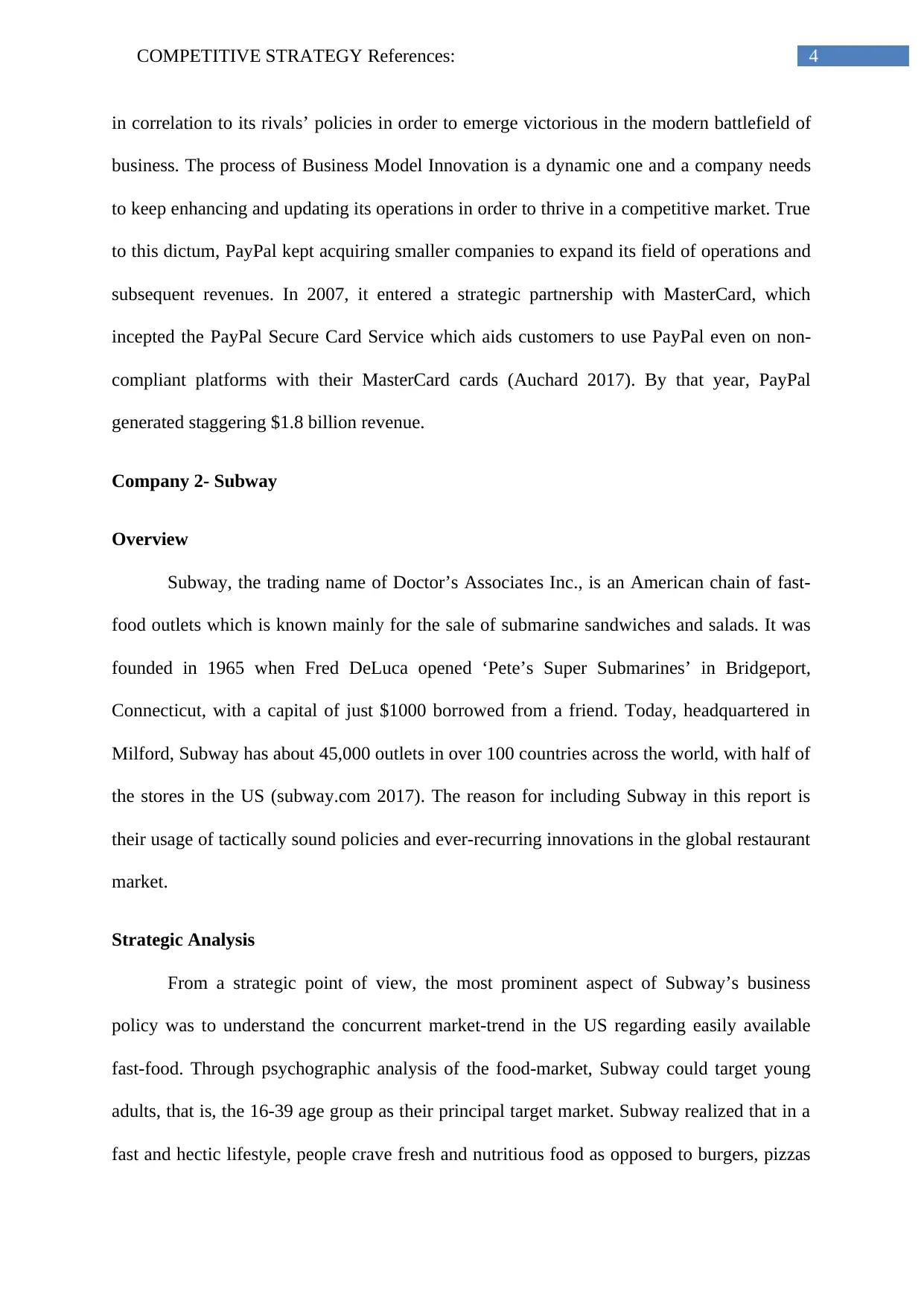
4COMPETITIVE STRATEGY References:
in correlation to its rivals’ policies in order to emerge victorious in the modern battlefield of
business. The process of Business Model Innovation is a dynamic one and a company needs
to keep enhancing and updating its operations in order to thrive in a competitive market. True
to this dictum, PayPal kept acquiring smaller companies to expand its field of operations and
subsequent revenues. In 2007, it entered a strategic partnership with MasterCard, which
incepted the PayPal Secure Card Service which aids customers to use PayPal even on non-
compliant platforms with their MasterCard cards (Auchard 2017). By that year, PayPal
generated staggering $1.8 billion revenue.
Company 2- Subway
Overview
Subway, the trading name of Doctor’s Associates Inc., is an American chain of fast-
food outlets which is known mainly for the sale of submarine sandwiches and salads. It was
founded in 1965 when Fred DeLuca opened ‘Pete’s Super Submarines’ in Bridgeport,
Connecticut, with a capital of just $1000 borrowed from a friend. Today, headquartered in
Milford, Subway has about 45,000 outlets in over 100 countries across the world, with half of
the stores in the US (subway.com 2017). The reason for including Subway in this report is
their usage of tactically sound policies and ever-recurring innovations in the global restaurant
market.
Strategic Analysis
From a strategic point of view, the most prominent aspect of Subway’s business
policy was to understand the concurrent market-trend in the US regarding easily available
fast-food. Through psychographic analysis of the food-market, Subway could target young
adults, that is, the 16-39 age group as their principal target market. Subway realized that in a
fast and hectic lifestyle, people crave fresh and nutritious food as opposed to burgers, pizzas
in correlation to its rivals’ policies in order to emerge victorious in the modern battlefield of
business. The process of Business Model Innovation is a dynamic one and a company needs
to keep enhancing and updating its operations in order to thrive in a competitive market. True
to this dictum, PayPal kept acquiring smaller companies to expand its field of operations and
subsequent revenues. In 2007, it entered a strategic partnership with MasterCard, which
incepted the PayPal Secure Card Service which aids customers to use PayPal even on non-
compliant platforms with their MasterCard cards (Auchard 2017). By that year, PayPal
generated staggering $1.8 billion revenue.
Company 2- Subway
Overview
Subway, the trading name of Doctor’s Associates Inc., is an American chain of fast-
food outlets which is known mainly for the sale of submarine sandwiches and salads. It was
founded in 1965 when Fred DeLuca opened ‘Pete’s Super Submarines’ in Bridgeport,
Connecticut, with a capital of just $1000 borrowed from a friend. Today, headquartered in
Milford, Subway has about 45,000 outlets in over 100 countries across the world, with half of
the stores in the US (subway.com 2017). The reason for including Subway in this report is
their usage of tactically sound policies and ever-recurring innovations in the global restaurant
market.
Strategic Analysis
From a strategic point of view, the most prominent aspect of Subway’s business
policy was to understand the concurrent market-trend in the US regarding easily available
fast-food. Through psychographic analysis of the food-market, Subway could target young
adults, that is, the 16-39 age group as their principal target market. Subway realized that in a
fast and hectic lifestyle, people crave fresh and nutritious food as opposed to burgers, pizzas
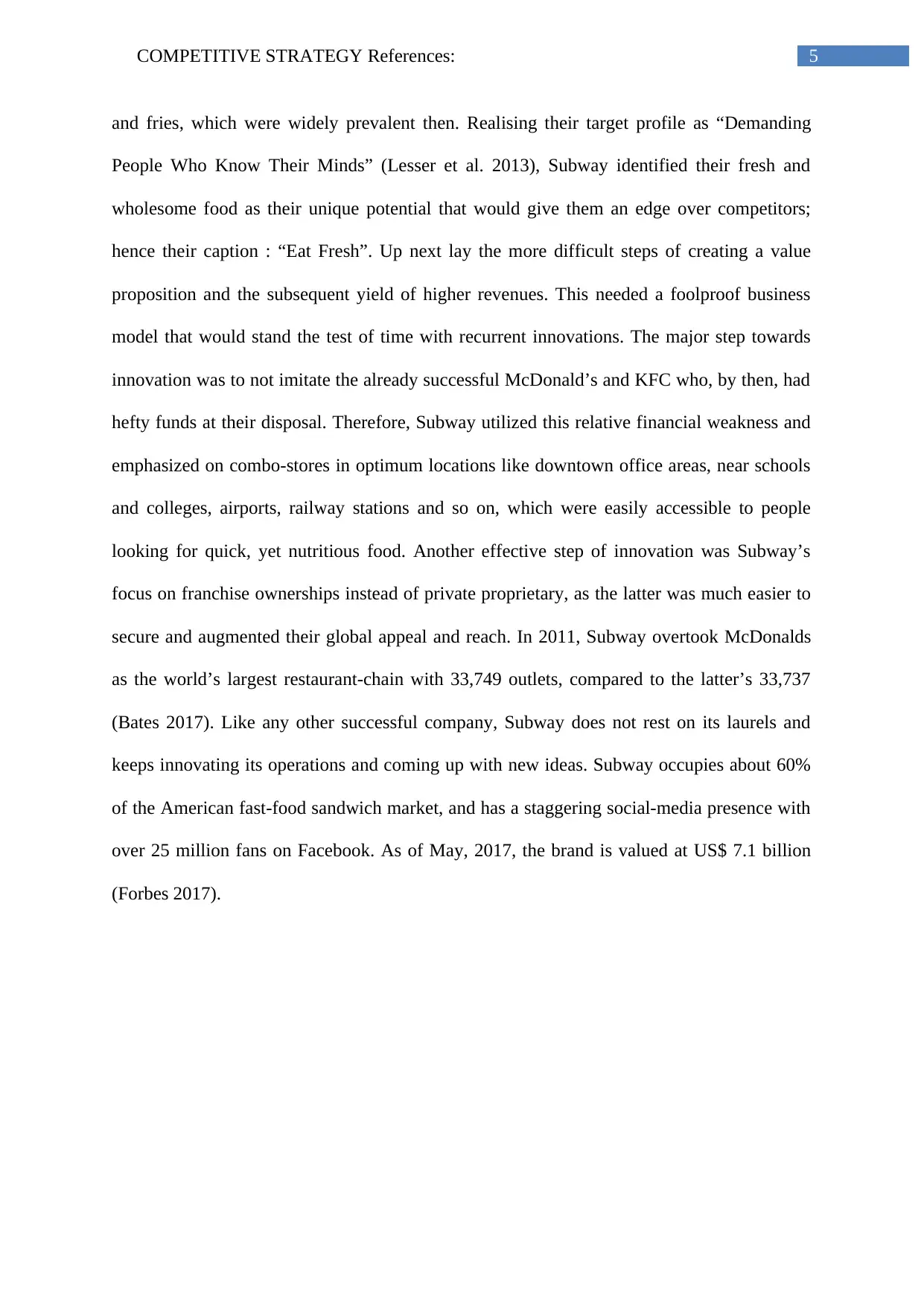
5COMPETITIVE STRATEGY References:
and fries, which were widely prevalent then. Realising their target profile as “Demanding
People Who Know Their Minds” (Lesser et al. 2013), Subway identified their fresh and
wholesome food as their unique potential that would give them an edge over competitors;
hence their caption : “Eat Fresh”. Up next lay the more difficult steps of creating a value
proposition and the subsequent yield of higher revenues. This needed a foolproof business
model that would stand the test of time with recurrent innovations. The major step towards
innovation was to not imitate the already successful McDonald’s and KFC who, by then, had
hefty funds at their disposal. Therefore, Subway utilized this relative financial weakness and
emphasized on combo-stores in optimum locations like downtown office areas, near schools
and colleges, airports, railway stations and so on, which were easily accessible to people
looking for quick, yet nutritious food. Another effective step of innovation was Subway’s
focus on franchise ownerships instead of private proprietary, as the latter was much easier to
secure and augmented their global appeal and reach. In 2011, Subway overtook McDonalds
as the world’s largest restaurant-chain with 33,749 outlets, compared to the latter’s 33,737
(Bates 2017). Like any other successful company, Subway does not rest on its laurels and
keeps innovating its operations and coming up with new ideas. Subway occupies about 60%
of the American fast-food sandwich market, and has a staggering social-media presence with
over 25 million fans on Facebook. As of May, 2017, the brand is valued at US$ 7.1 billion
(Forbes 2017).
and fries, which were widely prevalent then. Realising their target profile as “Demanding
People Who Know Their Minds” (Lesser et al. 2013), Subway identified their fresh and
wholesome food as their unique potential that would give them an edge over competitors;
hence their caption : “Eat Fresh”. Up next lay the more difficult steps of creating a value
proposition and the subsequent yield of higher revenues. This needed a foolproof business
model that would stand the test of time with recurrent innovations. The major step towards
innovation was to not imitate the already successful McDonald’s and KFC who, by then, had
hefty funds at their disposal. Therefore, Subway utilized this relative financial weakness and
emphasized on combo-stores in optimum locations like downtown office areas, near schools
and colleges, airports, railway stations and so on, which were easily accessible to people
looking for quick, yet nutritious food. Another effective step of innovation was Subway’s
focus on franchise ownerships instead of private proprietary, as the latter was much easier to
secure and augmented their global appeal and reach. In 2011, Subway overtook McDonalds
as the world’s largest restaurant-chain with 33,749 outlets, compared to the latter’s 33,737
(Bates 2017). Like any other successful company, Subway does not rest on its laurels and
keeps innovating its operations and coming up with new ideas. Subway occupies about 60%
of the American fast-food sandwich market, and has a staggering social-media presence with
over 25 million fans on Facebook. As of May, 2017, the brand is valued at US$ 7.1 billion
(Forbes 2017).
⊘ This is a preview!⊘
Do you want full access?
Subscribe today to unlock all pages.

Trusted by 1+ million students worldwide
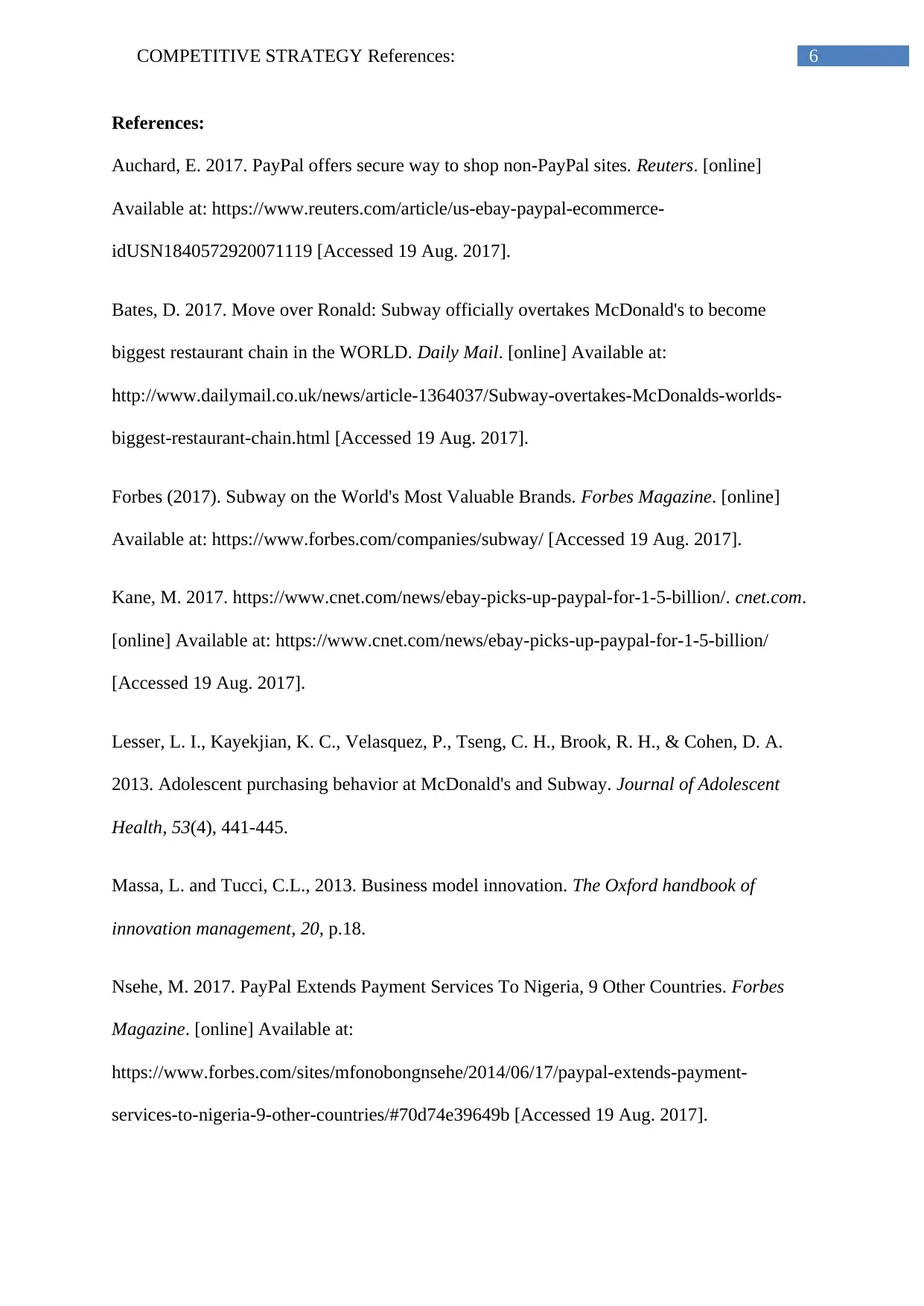
6COMPETITIVE STRATEGY References:
References:
Auchard, E. 2017. PayPal offers secure way to shop non-PayPal sites. Reuters. [online]
Available at: https://www.reuters.com/article/us-ebay-paypal-ecommerce-
idUSN1840572920071119 [Accessed 19 Aug. 2017].
Bates, D. 2017. Move over Ronald: Subway officially overtakes McDonald's to become
biggest restaurant chain in the WORLD. Daily Mail. [online] Available at:
http://www.dailymail.co.uk/news/article-1364037/Subway-overtakes-McDonalds-worlds-
biggest-restaurant-chain.html [Accessed 19 Aug. 2017].
Forbes (2017). Subway on the World's Most Valuable Brands. Forbes Magazine. [online]
Available at: https://www.forbes.com/companies/subway/ [Accessed 19 Aug. 2017].
Kane, M. 2017. https://www.cnet.com/news/ebay-picks-up-paypal-for-1-5-billion/. cnet.com.
[online] Available at: https://www.cnet.com/news/ebay-picks-up-paypal-for-1-5-billion/
[Accessed 19 Aug. 2017].
Lesser, L. I., Kayekjian, K. C., Velasquez, P., Tseng, C. H., Brook, R. H., & Cohen, D. A.
2013. Adolescent purchasing behavior at McDonald's and Subway. Journal of Adolescent
Health, 53(4), 441-445.
Massa, L. and Tucci, C.L., 2013. Business model innovation. The Oxford handbook of
innovation management, 20, p.18.
Nsehe, M. 2017. PayPal Extends Payment Services To Nigeria, 9 Other Countries. Forbes
Magazine. [online] Available at:
https://www.forbes.com/sites/mfonobongnsehe/2014/06/17/paypal-extends-payment-
services-to-nigeria-9-other-countries/#70d74e39649b [Accessed 19 Aug. 2017].
References:
Auchard, E. 2017. PayPal offers secure way to shop non-PayPal sites. Reuters. [online]
Available at: https://www.reuters.com/article/us-ebay-paypal-ecommerce-
idUSN1840572920071119 [Accessed 19 Aug. 2017].
Bates, D. 2017. Move over Ronald: Subway officially overtakes McDonald's to become
biggest restaurant chain in the WORLD. Daily Mail. [online] Available at:
http://www.dailymail.co.uk/news/article-1364037/Subway-overtakes-McDonalds-worlds-
biggest-restaurant-chain.html [Accessed 19 Aug. 2017].
Forbes (2017). Subway on the World's Most Valuable Brands. Forbes Magazine. [online]
Available at: https://www.forbes.com/companies/subway/ [Accessed 19 Aug. 2017].
Kane, M. 2017. https://www.cnet.com/news/ebay-picks-up-paypal-for-1-5-billion/. cnet.com.
[online] Available at: https://www.cnet.com/news/ebay-picks-up-paypal-for-1-5-billion/
[Accessed 19 Aug. 2017].
Lesser, L. I., Kayekjian, K. C., Velasquez, P., Tseng, C. H., Brook, R. H., & Cohen, D. A.
2013. Adolescent purchasing behavior at McDonald's and Subway. Journal of Adolescent
Health, 53(4), 441-445.
Massa, L. and Tucci, C.L., 2013. Business model innovation. The Oxford handbook of
innovation management, 20, p.18.
Nsehe, M. 2017. PayPal Extends Payment Services To Nigeria, 9 Other Countries. Forbes
Magazine. [online] Available at:
https://www.forbes.com/sites/mfonobongnsehe/2014/06/17/paypal-extends-payment-
services-to-nigeria-9-other-countries/#70d74e39649b [Accessed 19 Aug. 2017].
Paraphrase This Document
Need a fresh take? Get an instant paraphrase of this document with our AI Paraphraser
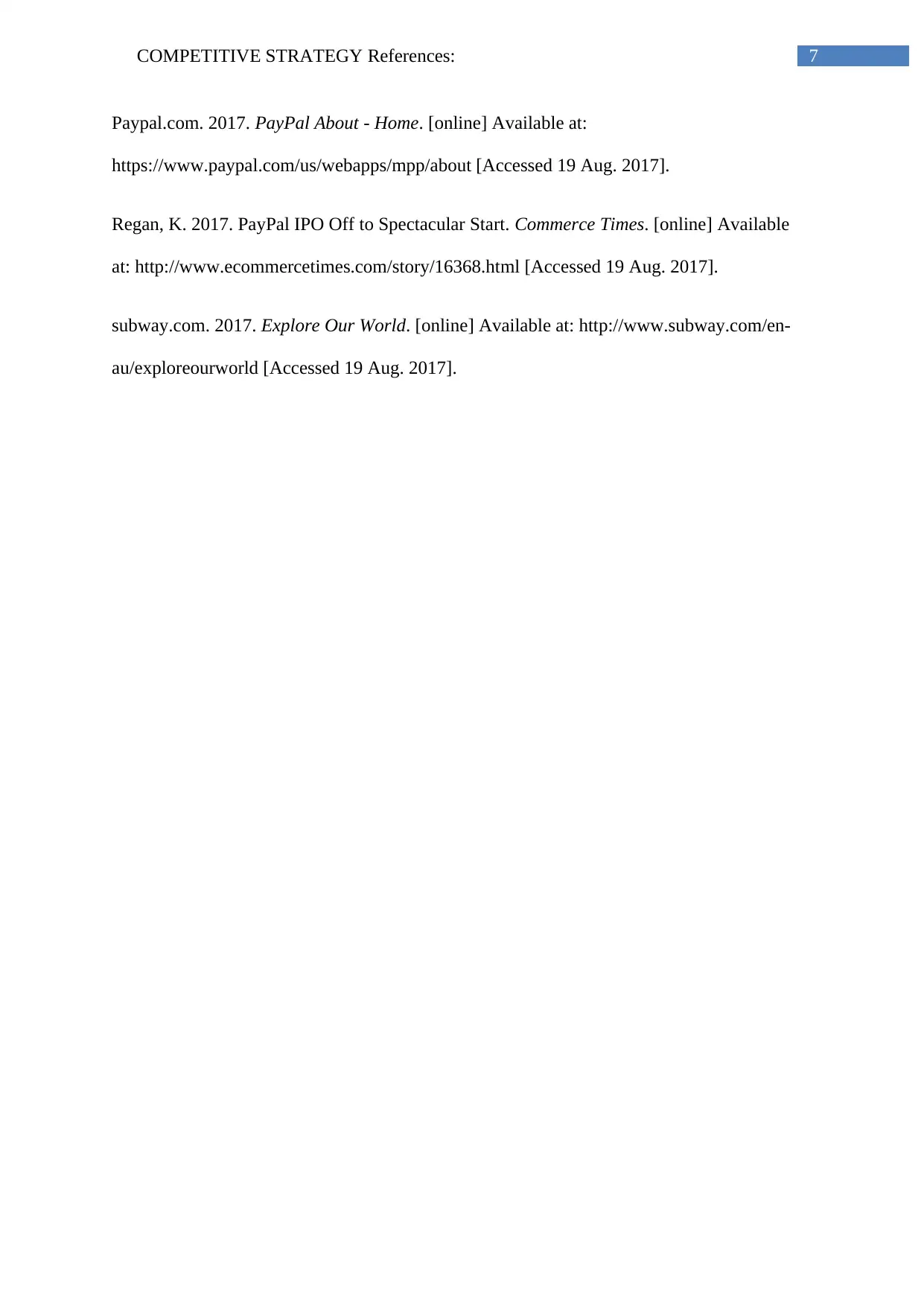
7COMPETITIVE STRATEGY References:
Paypal.com. 2017. PayPal About - Home. [online] Available at:
https://www.paypal.com/us/webapps/mpp/about [Accessed 19 Aug. 2017].
Regan, K. 2017. PayPal IPO Off to Spectacular Start. Commerce Times. [online] Available
at: http://www.ecommercetimes.com/story/16368.html [Accessed 19 Aug. 2017].
subway.com. 2017. Explore Our World. [online] Available at: http://www.subway.com/en-
au/exploreourworld [Accessed 19 Aug. 2017].
Paypal.com. 2017. PayPal About - Home. [online] Available at:
https://www.paypal.com/us/webapps/mpp/about [Accessed 19 Aug. 2017].
Regan, K. 2017. PayPal IPO Off to Spectacular Start. Commerce Times. [online] Available
at: http://www.ecommercetimes.com/story/16368.html [Accessed 19 Aug. 2017].
subway.com. 2017. Explore Our World. [online] Available at: http://www.subway.com/en-
au/exploreourworld [Accessed 19 Aug. 2017].
1 out of 8
Related Documents
Your All-in-One AI-Powered Toolkit for Academic Success.
+13062052269
info@desklib.com
Available 24*7 on WhatsApp / Email
![[object Object]](/_next/static/media/star-bottom.7253800d.svg)
Unlock your academic potential
Copyright © 2020–2025 A2Z Services. All Rights Reserved. Developed and managed by ZUCOL.



